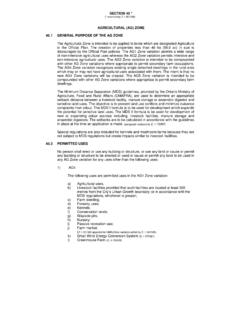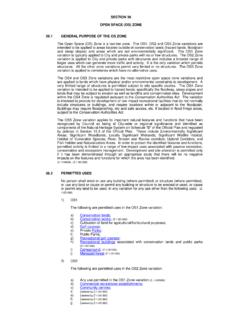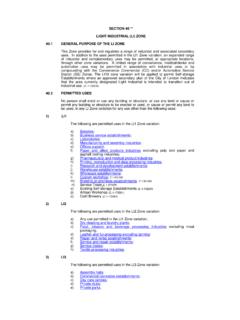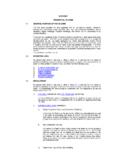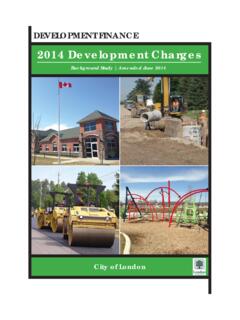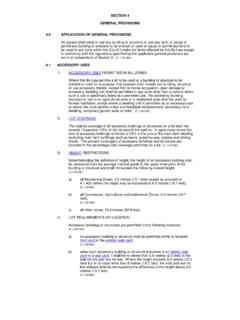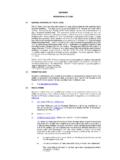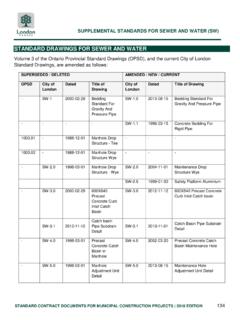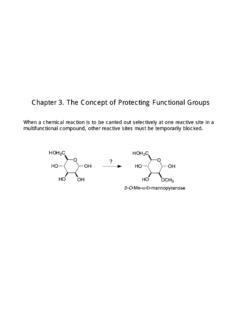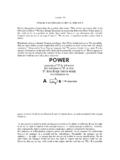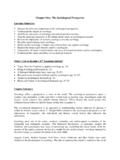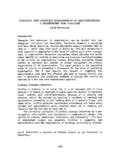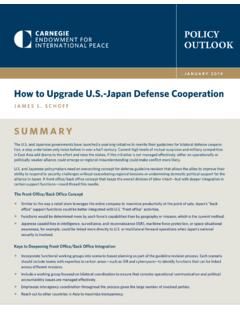Transcription of December 2011 - London, Ontario
1 Dillon Consulting Limited Poulton & Associates City of London Thames Valley Corridor Plan Final Report December 2011 Thames Valley Corridor Plan November 2011 Preamble The Thames River was one of the first rivers in the province formed after the last glacial retreat. As a gateway river, with a direct link via Lake St. Clair, the Great Lakes and the St. Lawrence River to the Atlantic Ocean, it has played a significant role in the human settlement and development of south-western Ontario .
2 In recognition of its outstanding natural and cultural contributions, quality recreational opportunities, and demonstration of a healthy river environment, the Thames River was recognized as a Canadian Heritage River in 2000. The Thames watershed spans the Carolinian and Great Lakes-St. Lawrence floristic zones; and, with over 90% located exclusively in the Carolinian zone, the Thames River is unique among major Canadian rivers. Although much altered by time and human activities, the Thames watershed is considered one of the most biologically diverse regions in Canada, containing remnants of rare tallgrass prairie and supporting woodlands containing sycamore, black walnut and hackberry.
3 Numerous species of wildflowers, ferns and sedges can be found in the understorey, including a number of rare species and species-at-risk. While the Thames River was nominated as a Canadian Heritage River on the basis of its cultural heritage and recreational attributes, its ecological values are also well recognized. It is by virtue of the dams located along the Thames that prevented the River s recognition under a natural heritage category. At a visionary level, it is hoped that the Thames Valley Corridor through London will continue to exemplify these attributes, supporting environmental and economic vitality, tourism, and local and regional recreation initiatives.
4 Functionally, the Corridor is a complex system of sensitive ecological habitats, intensive public recreation areas, and developed urban lands connected by multi-purpose trails and scenic by-ways. The balancing of these often competing demands to ensure the long-term sustainability of the river and the maintenance of its sensitive and vulnerable natural features is challenging. Effective management of land development, human uses and the natural environment will be important in maintaining this sensitive balance.
5 The City of London Official Plan Vision states that City Council will: protect and enhance natural features and attributes that are significant to the maintenance of ecosystem health in the Thames River and Kettle Creek watersheds ; and, an expanded system of parklands, natural areas and trails along the valley and ravines of the Thames River and Kettle Creek watersheds will provide continuous corridors for recreation, wildlife habitat and refuge from urban life. This Thames Valley Corridor Plan has been developed in the spirit of this Vision, through consultation with City of London staff, the Upper Thames River Conservation Authority, community and environmental organizations, and residents.
6 Acknowledgements City of London Steering Committee Members and Alternates Andrew Macpherson Manager, Parks Planning and Design Bruce Page Planner, Parks Planning and Design Bonnie Bergsma Ecologist, Planning and Development Rob Panzer General Manager, Planning and Development (retired March 2011 ) John Fleming Director of Land Use Planning Terry Grawey Planner, Planning and Development Nancy Pasato Planner, Planning and Development Jeff Bruin Planning and Development Sean Galloway Urban Designer, Planning and Development Pat Donnelly EES, Urban Watershed Program Manager Bill Coxhead Director Parks and Recreation, Community Services Berta Krichker Engineering, SWM Marty Rice Tourism London Robin Armistead Manager of Culture and Municipal Policy.
7 Culture Office Vanessa Kinsley Community Projects Coordinator Upper Thames River Conservation Authority Christine Creighton Land Use Planner, UTRCA Chris Harrington Coordinator Planning and Research, UTRCA Jeff Brick Coordinator of Hydrology and Regulatory Services, UTRCA Corridor Advisory Committee Peter Meisenheimer Urban League of London Anna Hopkins Urban League of London Dean Sheppard Environment and Ecological Planning Advisory Committee Mary E. Kerr Thames Talbot Land Trust Rosemary Dickinson Friends of Sifton Bog Jack Lorimer Nature London Bill De Young Thames Canadian Heritage River Committee Hilary Neary Historic Sites Committee, London Public Library Randy Richmond London Free Press Don Fairbanks Ontario Federation of Anglers and Hunters Jim Cushing London Advisory Committee for Heritage.
8 Nature London George Qubty University of Western Ontario Roy Langille University of Western Ontario We would like to thank all those individuals and organizations that participated in the various consultation events and provided comments or completed questionnaires. We truly appreciate your time and input. We would like also like to thank City staff and agency representatives not listed here whose efforts directly or indirectly contributed to the completion of this study. Thames Valley Corridor Plan November 2011 Table of Contents Introduction p.
9 1 Thames Valley Corridor Concept Plan p. 7 Recommendations p. 24 Implementation Strategy p. 31 Figures Figure 1: Land Use Context Figure 2: The Forks Figures 3 a, b, c, d - Main Branch Figures 4 a, b, c, d - North Branch Figures 5 a, b, c - South Branch Tables Table 1: Action Plan p. 35 Appendix A - Official Plan Policies B - Restoration and Management Plans Note: This document has been formatted for double sided printing. Blank pages in the digital file are intentional.
10 Introduction Background London has long recognized the important resources and multi- functional role that the Thames Valley Corridor contributes to the City s history and identity. The preparation of a Thames River Valley Corridor Plan (OP ) was identified as a key strategic environmental planning policy in 1996 and confirmed by the Ontario Municipal Board in 2000 by approving Official Plan Amendment #88 that contained the following policy directive: The City recognizes the Thames Valley Corridor as its most important natural, cultural, recreational and aesthetic resource.
